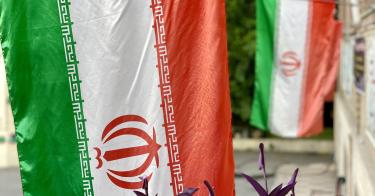A respected Washington nuclear nonproliferation think tank, the Institute for Science and International Security, reported last week that Iran’s “breakout time”—the time needed to produce enough fissile material for a nuclear weapon—is now at “zero.”
This is really no surprise.
Just a few weeks ago, Secretary of State Antony Blinken testified to Congress that Iran could have the uranium needed for a nuclear weapon in a few weeks if it decided to do so.
If the institute’s analysis is correct, the situation has only gotten more dire.
Essentially, Iran now “has enough 60 percent enriched uranium, or highly enriched uranium, to be assured it could fashion a nuclear explosive,” according to the institute’s report.
Using information gathered by the International Atomic Energy Agency—which monitors the Iranian nuclear program—the institute additionally assesses that in six months, Iran could amass enough enriched uranium for five nuclear weapons.
If accurate, that’s really bad news—and shines an unflattering and frightening—spotlight on the Biden administration’s faltering Iran policy.
Once a primary foreign policy objective, the administration’s efforts to fashion a new nuclear deal with Tehran to replace the deeply flawed 2015 Joint Comprehensive Plan of Action with a “longer and stronger” agreement has seemingly failed.
For more than a year now, the administration has been negotiating over the nuclear agreement in Vienna with Iran, along with Britain, France, Germany, China, and Russia. The talks stalled in March and have not resumed.
While the availability of the necessary fissile material is alarming, it remains unclear how long it would take Iran to fashion enriched uranium into a deployable nuclear warhead for a delivery system (e.g., a ballistic missile).
The Institute for Science and International Security report estimates that Iran could “deploy nuclear weapons on ballistic missiles in a year or two.”
A missile is an ideal delivery vehicle for a nuclear weapon. And, oh, by the way, Iran has the largest missile arsenal in the Middle East, including ballistic and cruise missiles that can strike the entirety of the region and southeastern Europe.
Iran is the only country to develop missiles with a range of 2,000 kilometers that did not already have nuclear weapons.
The cost of building such missiles outweighs the military utility of arming them with conventional warheads, particularly if they lack extremely accurate guidance systems, as do Iran’s current missiles.
Iran’s huge investment in such missiles makes little sense unless they eventually are intended to be tipped with nuclear warheads.
Yet despite mounting evidence of Iranian cheating on its Nuclear Non-Proliferation Treaty Safeguards Agreement, as documented in the most recent report by the International Atomic Energy Agency, the Biden administration appears stubbornly determined to resurrect the 2015 nuclear deal.
Nevertheless, as former Trump administration national security adviser John Bolton has argued, the steady drip of revelations about Iran’s nuclear deceptions may force the Biden administration to admit that the flawed and risky nuclear deal is not worth reviving.
If it remains narrowly fixated on restoring the illusory nuclear deal, then the Biden administration will pave the way for the world’s foremost state sponsor of terrorism to acquire the world’s most terrifying weapons.
The potential fallout from such a defective deal would be disastrous.
A nuclear Iran would shift the balance of power in the Middle East; increase the threat to U.S. forces, allies, and partners in the region; accelerate conventional arms races and nuclear proliferation; and further destabilize the region.
Critically important is that a nuclear Iran would give Tehran the freedom of action to escalate and expand its provocative policies, including its support of international terrorist organizations such as Hezbollah, Hamas, and Palestinian Islamic Jihad.
Crisis is a certainty; conflict is highly probable.
Unfortunately, the possibility of reaching a peaceful, diplomatic solution to the threats posed by Iran’s nuclear program looks remote at this moment, especially as Iran moves closer and closer to fielding a nuclear weapon.
The logical result of this—what seems like an inevitability—is that the United States, its allies, and partners need to start seriously thinking about dealing with more dangerous times ahead, arising from a nuclear-armed Iran.
This piece originally appeared in The Daily Signal



